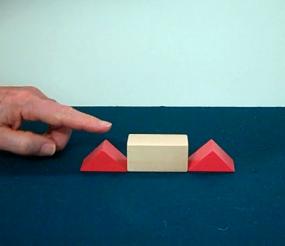The Language of Blocks, Part II – Symmetry

Beginning in the first year of life when children bang identically shaped blocks together at the mid line, symmetry evolves into finished structures of increasing complexity. Placing two same-shaped blocks side-by-side as a finished product captures the mid-air action of banging them together. As the child reflects on the symmetry of side-by-side, he tries to create other forms of symmetry, such as bisecting a lower block with a smaller block placed on top, thereby making the two empty spaces on each side of the smaller block equal. Later, the child figures out how to create symmetry with three blocks, using two identical blocks as book ends for a uniquely shaped middle block. Each stage requires the child to consider a greater number of spatial relations than the previous stage and thus explains the developmental sequence. Listen to the narrator (George Forman) explain how the symmetrical structures that children make can be understood as a language of spatial relations and the beginning of the mathematical concept of equivalence. The stages of block play mentioned in this video come from a two year research project by George Forman, David Kuschner, and Jean Dempsey, published in Action and Thought, 1982, New York: Academic Press. Runtime: 5 minutes 23 seconds
